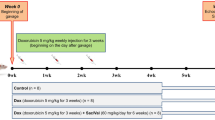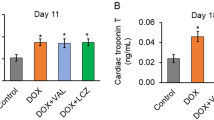Abstract
Fosinopril, an angiotensin-converting enzyme inhibitor, is known to attenuate cardiomyopathy induced by doxorubicin (DOX); however, the mechanisms of this cardioprotection are not fully elucidated yet. In the present study, experimental cardiomyopathy was induced in rats by administration of DOX with or without co-treatment with fosinopril. Fosinopril was utilized on day 1 or 14 of the treatment with DOX to compare efficacies of early versus late co-treatments. We observed that fosinopril attenuated changes induced by DOX (e.g., less increased heart and left ventricular weights, diminished lung congestion and ascites, attenuated LVEDP and LVSP, and less decreased +dP/dt and −dP/dt). Further, fosinopril diminished the levels of markers of cardiac toxicity (i.e., plasma levels and activities of cardiac enzymes and proteins AST, LDH, CPK, cTnI, and BNP). Fosinopril also prevented DOX-induced decreases in Ca2+ uptake and restored activity of Ca2+-stimulated ATPase in left ventricular sarcoplasmic reticulum. We next tested whether the improved Ca2+ transport activity in sarcoplasmic reticulum was due to modulation of SERCA2 and phospholamban expressions by fosinopril. Fosinopril attenuated the decrease in SERCA2 and phospholamban expressions caused by DOX. In conclusion, cardioprotective effects of fosinopril in the DOX-induced cardiomyopathy appear to be due to its ability to prevent remodeling of the cardiac sarcoplasmic reticulum membrane.





Similar content being viewed by others
References
Nakamura, T., Ueda, Y., Juan, Y., Katsuda, S., Takahashi, H., & Koh, E. (2000). Fas-mediated apoptosis in adriamycin-induced cardiomyopathy in rats: In vivo study. Circulation, 102, 572–578.
Kim, S. Y., Kim, S. J., Kim, B. J., Rah, S. Y., Chung, S. M., Im, M. J., et al. (2006). Doxorubicin-induced reactive oxygen species generation and intracellular Ca2+ increase are reciprocally modulated in rat cardiomyocytes. Experimental and Molecular Medicine, 38, 535–545.
Olson, R. D., Gambliel, H. A., Vestal, R. E., Shadle, S. E., Charlier, H. A., Jr, & Cusack, B. J. (2005). Doxorubicin cardiac dysfunction: effects on calcium regulatory proteins, sarcoplasmic reticulum, and triiodothyronine. Cardiovascular Toxicology, 5, 269–283.
Ondrias, K., Borgatta, L., Kim, D. H., & Ehrlich, B. E. (1990). Biphasic effects of doxorubicin on the calcium release channel from sarcoplasmic reticulum of cardiac muscle. Circulation Research, 67, 1167–1174.
Dhalla, N. S., Shao, Q., & Panagia, V. (1998). Remodeling of cardiac membranes during the development of congestive heart failure. Heart Failure Reviews, 2, 261–272.
Kim, E., Giri, S. N., & Pessah, I. N. (1995). Iron(II) is a modulator of ryanodine-sensitive calcium channels of cardiac muscle sarcoplasmic reticulum. Toxicology and Applied Pharmacology, 130, 57–66.
Lachnit, W. G., Phillips, M., Gayman, K. J., & Pessah, I. N. (1994). Ryanodine and dihydropyridine binding patterns and ryanodine receptor mRNA levels in myopathic hamster heart. American Journal of Physiology, 267, H1205–H1213.
Huang, X. M., Zhu, W. H., & Kang, M. L. (2003). Study on the effect of doxorubicin on expressions of genes encoding myocardial sarcoplasmic reticulum Ca2+ transport proteins and the effect of taurine on myocardial protection in rabbits. Journal of Zhejiang University—Science, 4, 114–120.
Boateng, S. Y., Seymour, A. M., Bhutta, N. S., Dunn, M. J., Yacoub, M. H., & Boheler, K. R. (1998). Sub-antihypertensive doses of ramipril normalize sarcoplasmic reticulum calcium ATPase expression and function following cardiac hypertrophy in rats. Journal of Molecular and Cellular Cardiology, 30, 2683–2694.
Guo, X., Chapman, D., & Dhalla, N. S. (2003). Partial prevention of changes in SR gene expression in congestive heart failure due to myocardial infarction by enalapril or losartan. Molecular and Cellular Biochemistry, 254, 163–172.
Shao, Q., Ren, B., Saini, H. K., Netticadan, T., Takeda, N., & Dhalla, N. S. (2005). Sarcoplasmic reticulum Ca2+ transport and gene expression in congestive heart failure are modified by imidapril treatment. American Journal of Physiology—Heart and Circulatory Physiology, 288, H1674–H1682.
Dhalla, N. S., Wang, S., & Beamish, R. E. (1996). Intracellular calcium handling in normal and failing hearts. Experimental & Clinical Cardiology, 1, 7–20.
Siveski-Iliskovic, N., Kaul, N., & Singal, P. K. (1994). Probucol promotes endogenous antioxidants and provides protection against adriamycin-induced cardiomyopathy in rats. Circulation, 89, 2829–2835.
Ganguly, P. K., Pierce, G. N., Dhalla, K. S., & Dhalla, N. S. (1983). Defective sarcoplasmic reticular calcium transport in diabetic cardiomyopathy. American Journal of Physiology, 244, E528–E535.
Afzal, N., & Dhalla, N. S. (1992). Differential changes in left and right ventricular SR calcium transport in congestive heart failure. American Journal of Physiology, 262, H868–H874.
Fabiato, A. (1988). Computer programs for calculating total from specified free or free from specified total ionic concentrations in aqueous solutions containing multiple metals and ligands. Methods in Enzymology, 157, 378–417.
Laemmli, U. K. (1970). Cleavage of structural proteins during the assembly of the head of bacteriophage T4. Nature, 227, 680–685.
Shaker, O., & Sourour, D. A. (2010). How to protect doxorubicin-induced cardiomyopathy in male albino rats? Journal of Cardiovascular Pharmacology, 55, 262–268.
Richard, C., Lauzier, B., Delemasure, S., Talbot, S., Ghibu, S., Collin, B., et al. (2008). Effects of angiotensin-1 converting enzyme inhibition on oxidative stress and bradykinin receptor expression during doxorubicin-induced cardiomyopathy in rats. Journal of Cardiovascular Pharmacology, 52, 278–285.
Soga, M., Kamal, F. A., Watanabe, K., Ma, M., Palaniyandi, S., Prakash, P., et al. (2006). Effects of angiotensin II receptor blocker (candesartan) in daunorubicin-induced cardiomyopathic rats. International Journal of Cardiology, 110, 378–385.
Georgakopoulos, P., Roussou, P., Matsakas, E., Karavidas, A., Anagnostopoulos, N., Marinakis, T., et al. (2010). Cardioprotective effect of metoprolol and enalapril in doxorubicin-treated lymphoma patients: A prospective, parallel-group, randomized, controlled study with 36-month follow-up. American Journal of Hematology, 85, 894–896.
Blaes, A. H., Gaillard, P., Peterson, B. A., Yee, D., & Virnig, B. (2010). Angiotensin converting enzyme inhibitors may be protective against cardiac complications following anthracycline chemotherapy. Breast Cancer Research and Treatment, 122, 585–590.
Nakamae, H., Tsumura, K., Terada, Y., Nakane, T., Nakamae, M., Ohta, K., et al. (2005). Notable effects of angiotensin II receptor blocker, valsartan, on acute cardiotoxic changes after standard chemotherapy with cyclophosphamide, doxorubicin, vincristine, and prednisolone. Cancer, 104, 2492–2498.
Kim, H. J., Ryu, J. H., Han, S. W., Park, I. K., Paik, S. S., Park, M. H., et al. (2004). Combined therapy of cilazapril and losartan has no additive effects in ameliorating adriamycin-induced glomerulopathy. Nephron Physiology, 97, 58–65.
Hiona, A., Lee, A. S., Nagendran, J., Xie, X., Connolly, A. J., Robbins, R. C., et al. (2011). Pretreatment with angiotensin-converting enzyme inhibitor improves doxorubicin-induced cardiomyopathy via preservation of mitochondrial function. Journal of Thoracic and Cardiovascular Surgery, 142, 396–403.
Watts, R. G. (1991). Severe and fatal anthracycline cardiotoxicity at cumulative doses below 400 mg/m2: Evidence for enhanced toxicity with multiagent chemotherapy. American Journal of Hematology, 1991(36), 217–218.
Kim, D. H., Landry, A. B., I. I. I., Lee, Y. S., & Katz, A. M. (1989). Doxorubicin-induced calcium release from cardiac sarcoplasmic reticulum vesicles. Journal of Molecular and Cellular Cardiology, 21, 433–436.
Chamberlain, B. K., & Fleischer, S. (1988). Isolation of canine cardiac sarcoplasmic reticulum. Methods in Enzymology, 157, 91–99.
Feldman, A. M., Weinberg, E. O., Ray, P. E., & Lorell, B. H. (1993). Selective changes in cardiac gene expression during compensated hypertrophy and the transition to cardiac decompensation in rats with chronic aortic banding. Circulation Research, 73, 184–192.
Arai, M., & Matsui, H. (1994). Sarcoplasmic reticulum gene expression in cardiac hypertrophy and heart failure. Circulation Research, 74, 555–564.
Hasenfuss, G., Reinecke, H., Studer, R., Meyer, M., Pieske, B., Holtz, J., et al. (1994). Relation between myocardial function and expression of sarcoplasmic reticulum Ca(2+)-ATPase in failing and nonfailing human myocardium. Circulation Research, 75, 434–442.
Takeishi, Y., Bhagwat, A., Ball, N. A., Kirkpatrick, D. L., Periasamy, M., & Walsh, R. A. (1999). Effect of angiotensin-converting enzyme inhibition on protein kinase C and SR proteins in heart failure. American Journal of Physiology, 276, H53–H62.
Lompre, A. M., Anger, M., & Levitsky, D. (1994). Sarco(endo)plasmic reticulum calcium pumps in the cardiovascular system: Function and gene expression. Journal of Molecular and Cellular Cardiology, 26, 1109–1121.
Acknowledgments
The authors gratefully acknowledge continuing support from the Natural Science Foundation of Shanghai Municipal Scientific Committee.
Author information
Authors and Affiliations
Corresponding authors
Additional information
Ya-chen Zhang and Yong Tang have contributed equally to the study.
Rights and permissions
About this article
Cite this article
Zhang, Yc., Tang, Y., Zhang, M. et al. Fosinopril Attenuates the Doxorubicin-induced Cardiomyopathy by Restoring the Function of Sarcoplasmic Reticulum. Cell Biochem Biophys 64, 205–211 (2012). https://doi.org/10.1007/s12013-012-9386-6
Published:
Issue Date:
DOI: https://doi.org/10.1007/s12013-012-9386-6




